
Newton, officially the Town of Newton, is an incorporated municipality and the county seat of Sussex County in the U.S. state of New Jersey, situated approximately 60 miles (97 km) northwest of New York City. As of the 2020 United States census, the town's population was 8,374, its highest decennial population ever, an increase of 377 (+4.7%) from the 2010 census count of 7,997, which in turn reflected a decrease of 247 (−3.0%) from the 8,244 counted in the 2000 census.
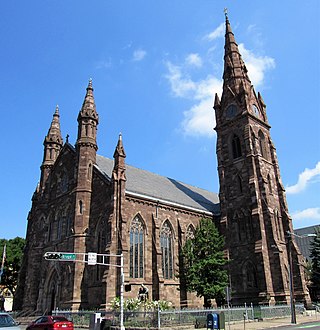
The Diocese of Paterson is a Latin Church ecclesiastical territory or diocese of the Catholic Church in the United States that encompasses Passaic, Morris, and Sussex counties in northern New Jersey. Most of this territory lies to the west of the episcopal see in Paterson. As of 2013, there were 166 active diocesan priests, 96 retired priests, 124 religious priests, 136 permanent deacons, 19 retired permanent deacons, 178 male religious and 677 female religious to serve 426,000 Catholics out of a total population of 1,143,500, ranking it 44th in Catholic population among dioceses in the United States. The patrons of the diocese are St. Patrick and St. John the Baptist, and its proper feasts are the Feast of St. Patrick, the Nativity of John the Baptist, the anniversary of the dedication of the cathedral church. The diocese is a suffragan diocese in the ecclesiastical province of the metropolitan Archdiocese of Newark, and is part of Region III of the United States Conference of Catholic Bishops.

Christ Church or Christ Episcopal Church is a historic Episcopal church in New Brunswick, Middlesex County, New Jersey.
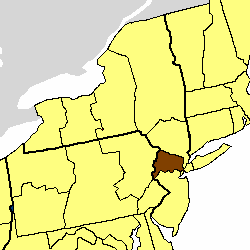
The Episcopal Diocese of Newark is a diocese of the Episcopal Church in the United States of America comprising the northern third of New Jersey in the United States. The Diocese represents the Anglican Communion, of which the Episcopal Church is a province, and presides over Episcopal parishes, missions, outreach ministries and schools in the New Jersey counties of Bergen, Essex, Hudson, Morris, Passaic, Sussex, Warren, and one church in Union County.
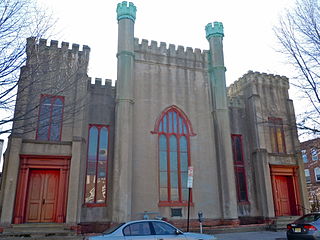
Established in 1703, St. Michael's Church in downtown Trenton, Mercer County, New Jersey, United States, is a founding parish of the Episcopal Diocese of New Jersey. Its present building located at 140 North Warren Street was built in 1747–1748, and was renovated in 1810 and 1847–1848. It was listed on the National Register of Historic Places on April 29, 1982 as St. Michael's Episcopal Church.

Robert Hamilton was an American lawyer, bank president and Democratic Party politician who represented New Jersey's 4th congressional district in the United States House of Representatives from 1873 to 1877.

Grace Church in Newark (Episcopal) is an active and historic Episcopal Church in the Diocese of Newark. It is located on Newark, New Jersey's Broad Street where it has stood since 1837. Grace is a traditional church that worships in the Catholic tradition. Grace is notable for its architecture, music, and as the birthplace of the tune "America the Beautiful".

Christ Church Cathedral is the cathedral for the Episcopal Diocese of Indianapolis. Christ Church parish was formally organized in 1837. The present-day church building was erected in 1857 on Monument Circle at the center of downtown Indianapolis to replace the parish's first church built on the same site. Designed by architect William Tinsley, the English Gothic Revival-style structure is the oldest church building in Indianapolis and Marion County, Indiana, that has remained in continuous use. It is also the oldest building on Monument Circle. Christ Church is known for its music, especially its pipe organs, one of which was donated by Ruth Lilly, and its professional Choir of Men and Boys and Girls' Choir. The parish is also known for its community service, including an annual strawberry festival fundraiser and other charitable work. Christ Church Cathedral was added to the National Register of Historic Places on July 10, 1973. It is located in the Washington Street-Monument Circle Historic District.

Calvary Episcopal Church is one of the largest Episcopal congregations in New Jersey. It belongs to the Episcopal Diocese of Newark of the Episcopal Church in the United States of America, a member of the Anglican Communion.
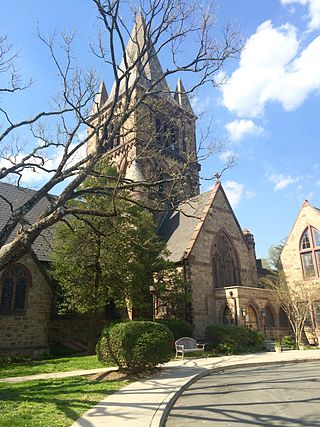
Trinity Church is a historic Episcopal congregation located at 33 Mercer Street in Princeton, New Jersey. It is the largest Episcopal church in New Jersey.

Trinity & St. Philip's Cathedral is a historic church located at Broad and Rector Streets in Military Park in the city of Newark in Essex County, New Jersey, United States. It is the seat of the Episcopal Diocese of Newark. The church building was added to the National Register of Historic Places on November 3, 1972, for its significance in architecture and religion. It was added as a contributing property to the Military Park Commons Historic District on June 18, 2004.

St. Peter's Episcopal Church is a historic church at Rector and Gordon Streets in Perth Amboy, Middlesex County, New Jersey. It is the oldest Episcopal parish in New Jersey and contains the oldest extant gravestone in New Jersey. The church building, built from 1849 to 1852 in Gothic style, was added to the National Register of Historic Places on May 12, 1977, for its significance in religion.

St. Barnabas' Episcopal Church, is located in Newark, Essex County, New Jersey, United States. The building was built in 1864 and was added to the National Register of Historic Places on October 18, 1972.

The Church of St. James the Greater is an Episcopal church located in the heart of the Bristol Historic District in Bristol Borough, Pennsylvania. It is part of the Episcopal Diocese of Pennsylvania and the Episcopal Church in the United States of America.
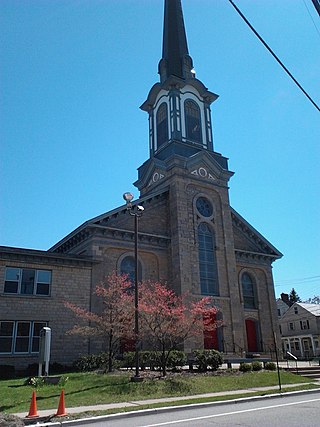
The First Presbyterian Church of Newton is a Christian house of worship affiliated with the Presbyterian Church (USA) located in the Town of Newton in Sussex County, New Jersey. This congregation, established in the 1780s, is overseen by the Presbytery of Newton.

Saint John's Episcopal Church in Jersey City, New Jersey is a disused church of the Episcopal Diocese of Newark. Located on Summit Avenue in Bergen Hill, it is considered a masterwork of 19th-century ecclesiastical architecture. The building, which was named a municipal landmark in 2013, has not housed a congregation since 1994, and has fallen into disrepair. There are proposals to convert the buildings on the grounds to housing.

Christ Church Cathedral is an Episcopal cathedral located in Springfield, Massachusetts, United States. It is the seat of the Diocese of Western Massachusetts. In 1974 the cathedral was included as a contributing property in the Quadrangle–Mattoon Street Historic District, listed on the National Register of Historic Places.

St. Peter's Episcopal Church is an active and historic Episcopal church in the Diocese of Newark in Morristown, New Jersey. Located on South Street, St. Peter's congregation has roots going back to the 1760s. Officially founded in 1827, with the current building consecrated in 1911, it is notable for its gothic-revival architecture, medieval interior and fine stained glass. St. Peter's congregation has traditionally worshipped in the High Church tradition. The church was added to the National Register of Historic Places, listed as a contributing property of the Morristown District, on October 30, 1973.
Thomas Richey was a prominent Irish-American Anglo-Catholic priest, professor, and author in the Episcopal Church. He was born in Newry, County Down, in Ireland and had settled in Pittsburgh by 1847, following his graduation at 16 from Queen's College, Belfast. Richey was a tutor at St. James College, Hagerstown, Maryland under John Barrett Kerfoot from 1848-1851. He was graduated from the General Theological Seminary of the Episcopal Church in 1854 and ordained to the priesthood by Bishop Horatio Potter in 1855.

























